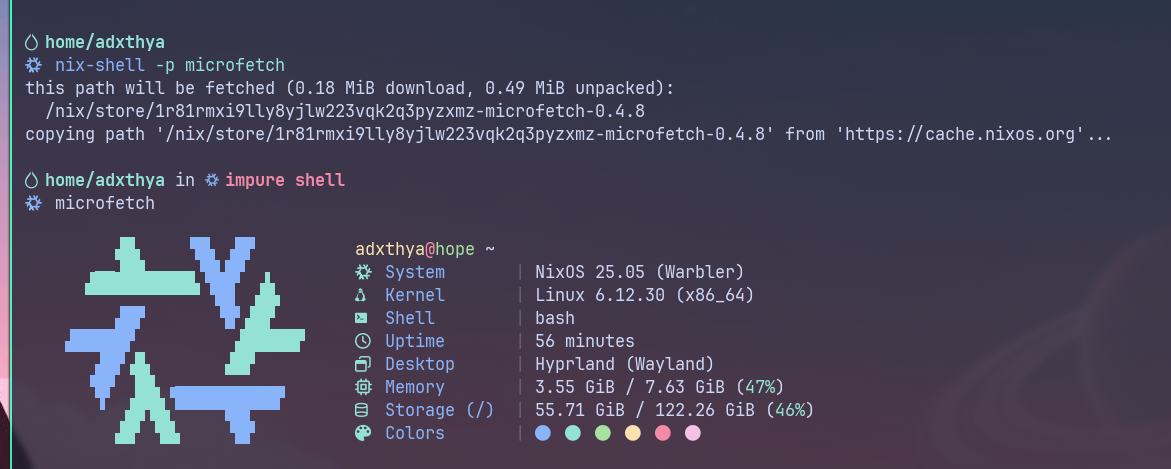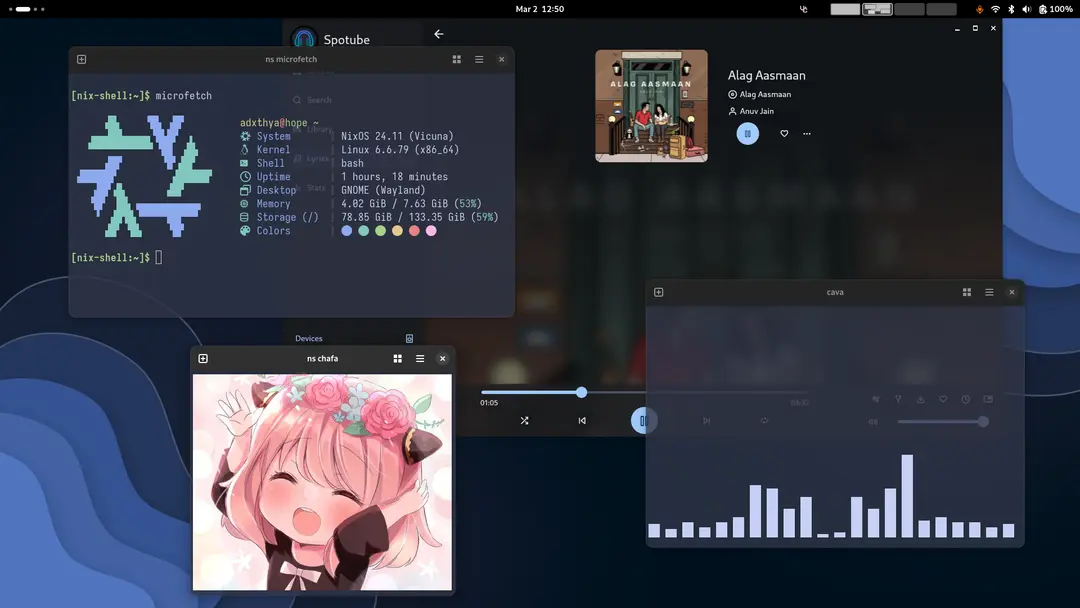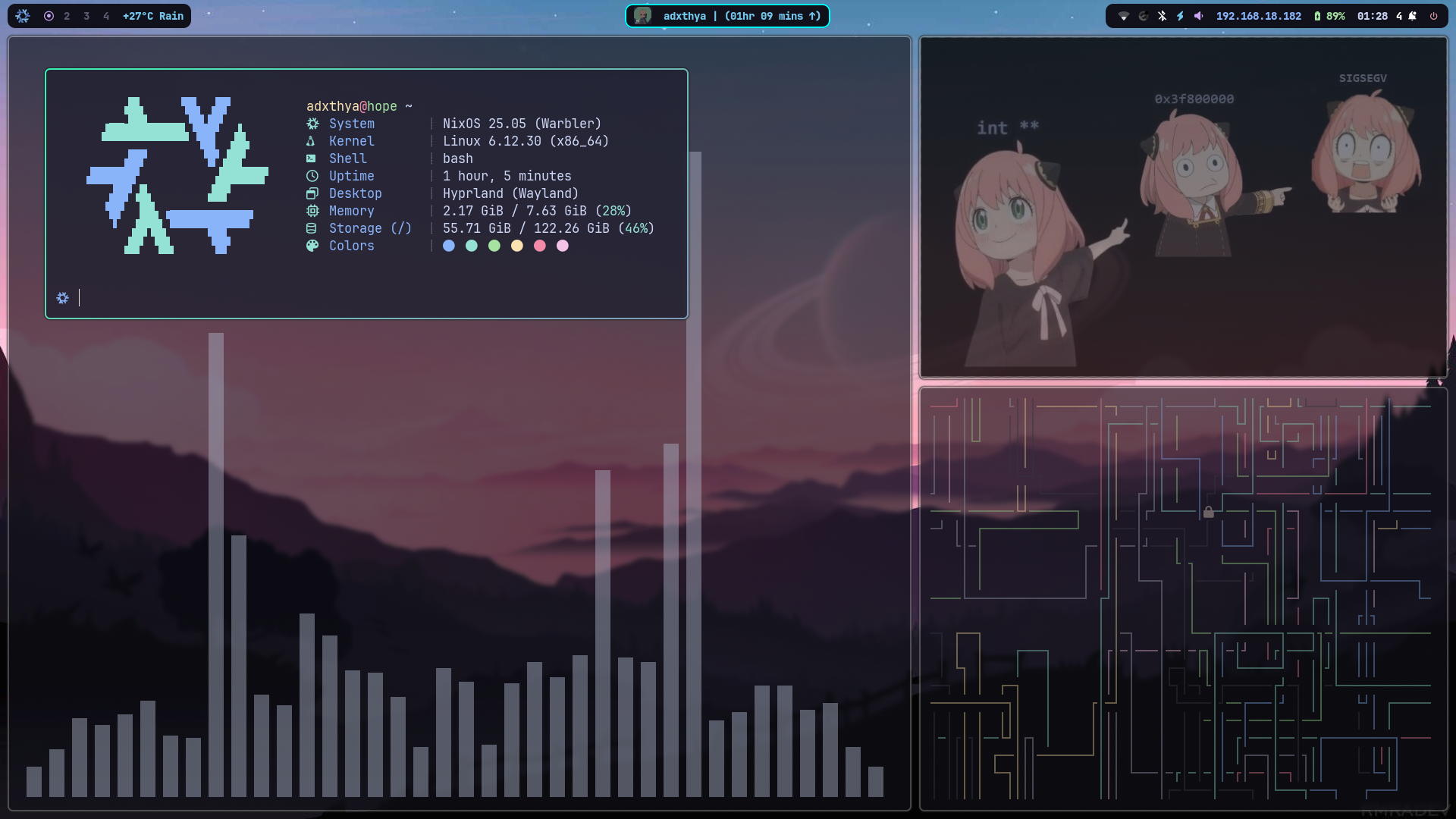NixOS - A Unique Linux Distribution
My Experience Using NixOS
NixOS - A Unique Linux Distribution
What is NixOS?
- NixOS is a declarative Linux distribution. It is based on the Nix package manager, allowing reproducibility and portability.
- It’s different from other distributions because of its non-FHS compliance and configuration.
- The whole configuration for the system is written inside a single configuration file
configuration.nix. You can also find ahardware-configuration.nix, which you probably never have to edit. It contains the configuration for the hardware. - After modifying the configuration files, you can run
sudo nixos-rebuild switchto apply the changes orsudo nixos-rebuild testto test the changes. - The
nixos-rebuild switchcommand creates a new generation. So, in case the system breaks, you can roll back to a previous generation.What is Nix?
- Nix is a purely functional package manager that allows for declarative installation of packages.
- Nix can be used as a package manager, not just in NixOS, but in other Linux distributions and even in macOS.
- Packages in Nix are built from Nix expressions, which is a simple functional language.
- It allows multiple versions of the same package to be installed. Due to its hashing scheme, they don’t interfere with each other.
- If you want to learn more about Nix, check out nix pills
What is Flakes?
- Flakes is an experimental yet popular feature in NixOS that allows the pinning of versions of dependencies, making the system more reproducible.
- The version is pinned in a
flake.lockfile, and the flake expression is written in aflake.nixfile. - The pinned versions can be updated to a higher version with the
nix flake updatecommand.What is Home-Manager?
- Home-Manager helps in managing the user environment using the Nix package manager.
- Home-Manager can be installed as a module or a standalone tool.
- It allows you to configure user-specific utilities. For example, you can write the config for Hyprland using Home-Manager so that when you build the system, the configs will be applied automatically.
- Here is an example of my ghostty config
1 2 3 4 5 6 7 8 9 10 11 12 13 14 15
{...}: { programs.ghostty = { enable = true; settings = { theme = "catppuccin-mocha"; font-size = 13; background-opacity = 0.8; font-family = "JetBrainsMono NF"; cursor-style = "bar"; window-padding-x = 10; window-padding-y = 10; confirm-close-surface = false; }; }; }
Views
- I personally think NixOS is a great Linux distribution that combines stability and recency.
- Since it’s non-FHS compliant, it might be hard switching to it initially. But once you get the hang of it, you’re good to go.
- This might be the best distro for ricing since you can rice without the fear of breaking your system. If you do break it, just roll back.
- I did have issues setting a few things up, which I can say was a nightmare.
- Not at all a beginner-friendly distro.
- The learning curve is very steep, but that depends on how deep you go. NixOS can be a rabbit hole.
- You will have an exact idea of what’s on your system since you are configuring almost everything declaratively.
- Best logo of all distros.
Notes
Note 1
- If you want to, say, set the GTK icon theme using the home-manager, you can fetch the package from nixpkgs but you may not know the exact theme name.
- Example
1 2
iconTheme.package = pkgs.dracula-icon-theme; iconTheme.name = "Dracula";
- Here you may not know the exact theme name to pass to the
iconTheme.name. To get the name, you can fetch the package and check the contents of it using the following command.1
cd $(nix build nixpkgs#dracula-icon-theme --print-out-paths --no-link)
- This command lets you check the contents of the theme folder and get the exact theme name from it.

- From this we can understand that the con theme name is Dracula.
Note 2
- This is a great website if you want to check what options are available for a particular package - https://mynixos.com/
Note 3
- Some themes or packages allow you to choose particular flavours to be installed instead of the whole theme/package.
- For example, the fluent GTK theme allows you to install particular flavours.
- You can select these specific flavours using the override option.
1 2 3 4 5 6
pkgs.fluent-gtk-theme.override { themeVariants = [ "purple" ]; colorVariants = [ "dark" ]; sizeVariants = [ "compact" ]; tweaks = [ "round" "noborder" ]; }
Note 4
- Some of the apps or themes that you need may not be available in nixpkgs. In such a situation, you will have to write your own nix derivation for it.
- Here is a resource you can reference for writing your own derivation - write your own derivation
Note 5
- In NixOS, you will generally use dev shells for setting up the development environment. The nix way of setting up a development environment is to create a dev shell.
- For example, for web development, you don’t install Bun/Node globally. Instead you write a flake that activates a shell env with Node/Bun in it.
- Here is a collection of dev shell templates - nix dev shell templates
Note 6
- You can also build your own NixOS Installer ISO, So that all your configs will be applied as soon as you install NixOS.
- I’ll link Vimjoyer’s video on this. He does great content on NixOS. Vimjoyer’s Video
Note 7
- When you modularize your NixOS config and write the config for each package in a separate file, make sure the file is staged before you run
sudo nixos-rebuild switchorhome-manager switchif the directory is git initialized. - Or else Nix will throw an error that the file does not exist, even though it does.
Note 8
- You can also temporarily install packages with
nix-shell -p <packageName>. These packages only exist temporarily inside that particular shell. They are not installed globally. - Here is an example

- Here, Microfetch by raf (also check out nvf by raf if you use neovim) is installed using nix-shell, which is only available in that particular shell.
Utilities
Nix-Direnv
- Github - nix-direnv
- As explained in the notes earlier, dev shells are created for development purposes. But activating the dev shell everytime you need to code can be tiresome and redundant.
- That’s why we have nix-direnv.
- Nix-Direnv will activate the dev shell every time you switch to a folder with a
flake.nixorshell.nix.NVF
- If you are a Neovim user, you might find it hard to set things up and configure Neovim in Nixos.
- So to solve this problem, we have nvf.
- Here’s a video by vimjoyer on how to get started with nvf - Configure neovim with nvf
NH
- When you update your system the default way using
sudo nixos-rebuild switch, you wouldn’t see much information on what changed during the update. - NH allows you to get a better understanding on what is being done during the switch and what packages were removed/installed after the switch.
- You can also set NH to automate the task of removing the old system generations.
Config
- Here’s my config
- Nixos Hyprland Config - Config
- Gnome

- Hyprland

This post is licensed under CC BY 4.0 by the author.
